Case Study Analysis: Palliative Approach in Nursing Care
VerifiedAdded on 2022/10/15
|9
|2365
|151
Case Study
AI Summary
This case study focuses on a palliative approach to patient care, addressing various aspects such as pain management, shortness of breath, fatigue, and skin integrity. The assignment explores the importance of nurses' emotional well-being in handling end-of-life situations and discusses the benefits and burdens associated with palliative care. It identifies key issues affecting the patient's comfort, including pain and shortness of breath, and proposes specific nursing interventions to address these challenges. The study also emphasizes the importance of fulfilling the patient's spiritual needs and provides interventions to ensure her wishes are met, including informing the priest and family about her end-of-life stage. Furthermore, it highlights the significance of assessing and maintaining the patient's skin integrity through daily assessment and hygiene practices. The case study references relevant literature to support its findings and recommendations.
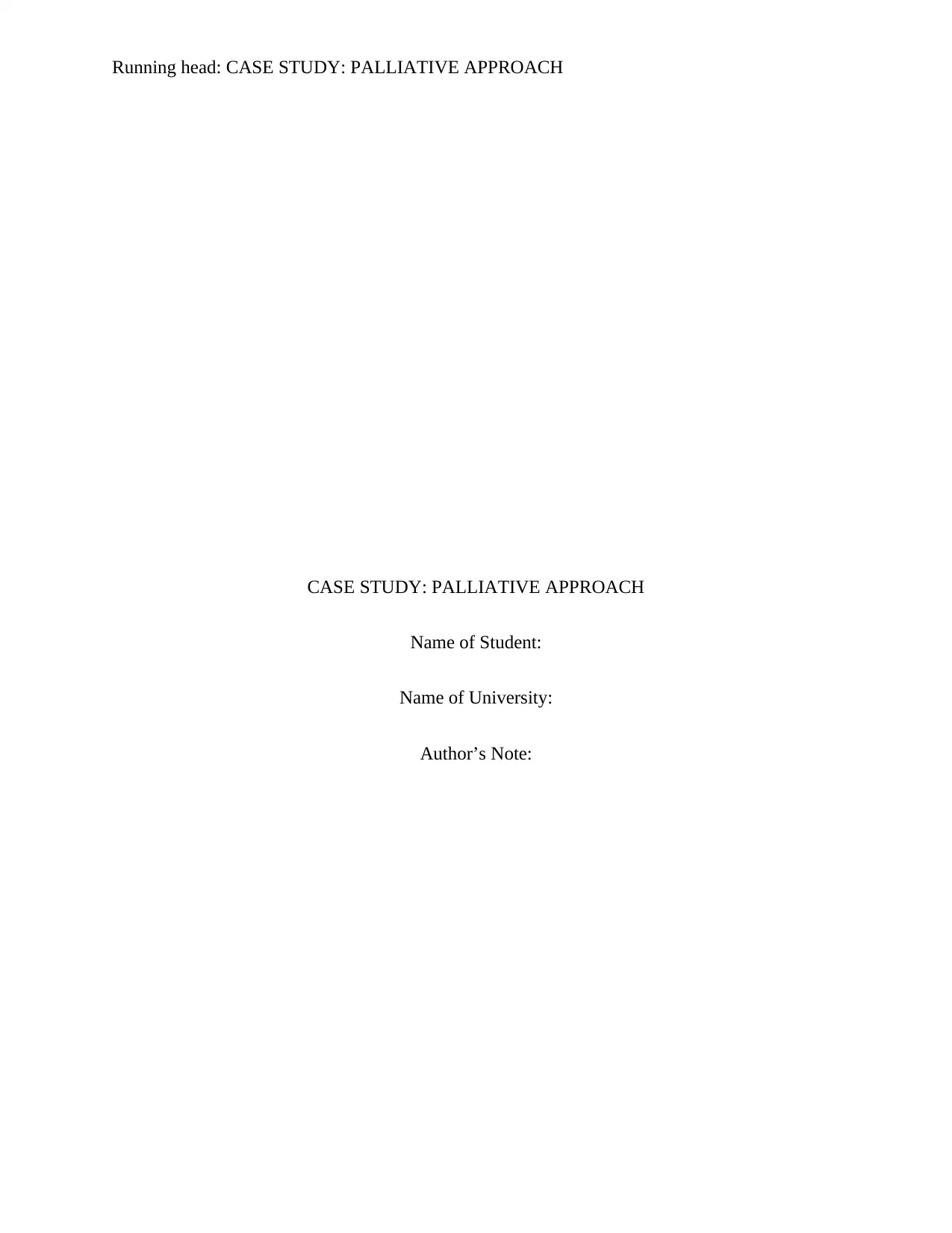
Running head: CASE STUDY: PALLIATIVE APPROACH
CASE STUDY: PALLIATIVE APPROACH
Name of Student:
Name of University:
Author’s Note:
CASE STUDY: PALLIATIVE APPROACH
Name of Student:
Name of University:
Author’s Note:
Paraphrase This Document
Need a fresh take? Get an instant paraphrase of this document with our AI Paraphraser
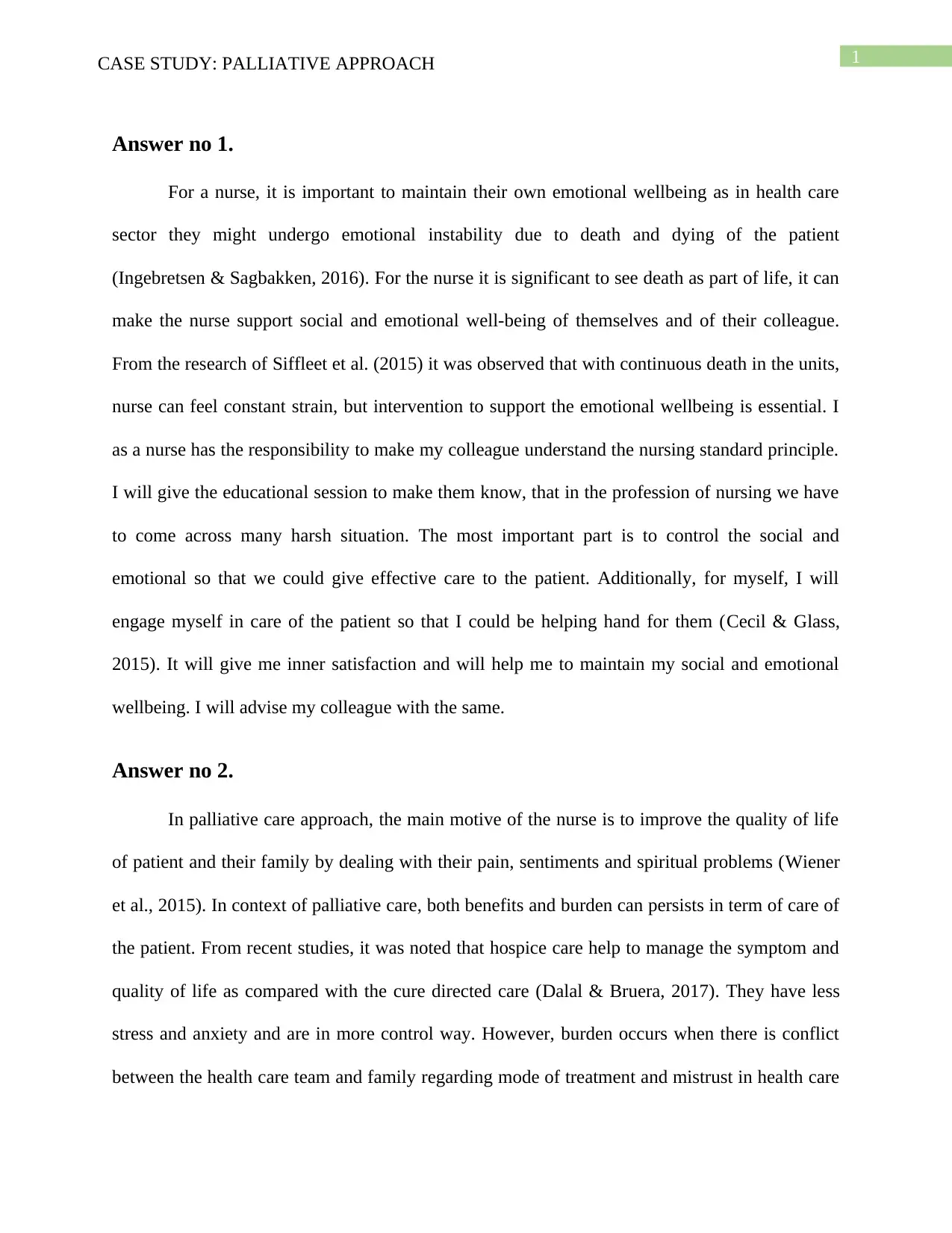
1CASE STUDY: PALLIATIVE APPROACH
Answer no 1.
For a nurse, it is important to maintain their own emotional wellbeing as in health care
sector they might undergo emotional instability due to death and dying of the patient
(Ingebretsen & Sagbakken, 2016). For the nurse it is significant to see death as part of life, it can
make the nurse support social and emotional well-being of themselves and of their colleague.
From the research of Siffleet et al. (2015) it was observed that with continuous death in the units,
nurse can feel constant strain, but intervention to support the emotional wellbeing is essential. I
as a nurse has the responsibility to make my colleague understand the nursing standard principle.
I will give the educational session to make them know, that in the profession of nursing we have
to come across many harsh situation. The most important part is to control the social and
emotional so that we could give effective care to the patient. Additionally, for myself, I will
engage myself in care of the patient so that I could be helping hand for them (Cecil & Glass,
2015). It will give me inner satisfaction and will help me to maintain my social and emotional
wellbeing. I will advise my colleague with the same.
Answer no 2.
In palliative care approach, the main motive of the nurse is to improve the quality of life
of patient and their family by dealing with their pain, sentiments and spiritual problems (Wiener
et al., 2015). In context of palliative care, both benefits and burden can persists in term of care of
the patient. From recent studies, it was noted that hospice care help to manage the symptom and
quality of life as compared with the cure directed care (Dalal & Bruera, 2017). They have less
stress and anxiety and are in more control way. However, burden occurs when there is conflict
between the health care team and family regarding mode of treatment and mistrust in health care
Answer no 1.
For a nurse, it is important to maintain their own emotional wellbeing as in health care
sector they might undergo emotional instability due to death and dying of the patient
(Ingebretsen & Sagbakken, 2016). For the nurse it is significant to see death as part of life, it can
make the nurse support social and emotional well-being of themselves and of their colleague.
From the research of Siffleet et al. (2015) it was observed that with continuous death in the units,
nurse can feel constant strain, but intervention to support the emotional wellbeing is essential. I
as a nurse has the responsibility to make my colleague understand the nursing standard principle.
I will give the educational session to make them know, that in the profession of nursing we have
to come across many harsh situation. The most important part is to control the social and
emotional so that we could give effective care to the patient. Additionally, for myself, I will
engage myself in care of the patient so that I could be helping hand for them (Cecil & Glass,
2015). It will give me inner satisfaction and will help me to maintain my social and emotional
wellbeing. I will advise my colleague with the same.
Answer no 2.
In palliative care approach, the main motive of the nurse is to improve the quality of life
of patient and their family by dealing with their pain, sentiments and spiritual problems (Wiener
et al., 2015). In context of palliative care, both benefits and burden can persists in term of care of
the patient. From recent studies, it was noted that hospice care help to manage the symptom and
quality of life as compared with the cure directed care (Dalal & Bruera, 2017). They have less
stress and anxiety and are in more control way. However, burden occurs when there is conflict
between the health care team and family regarding mode of treatment and mistrust in health care
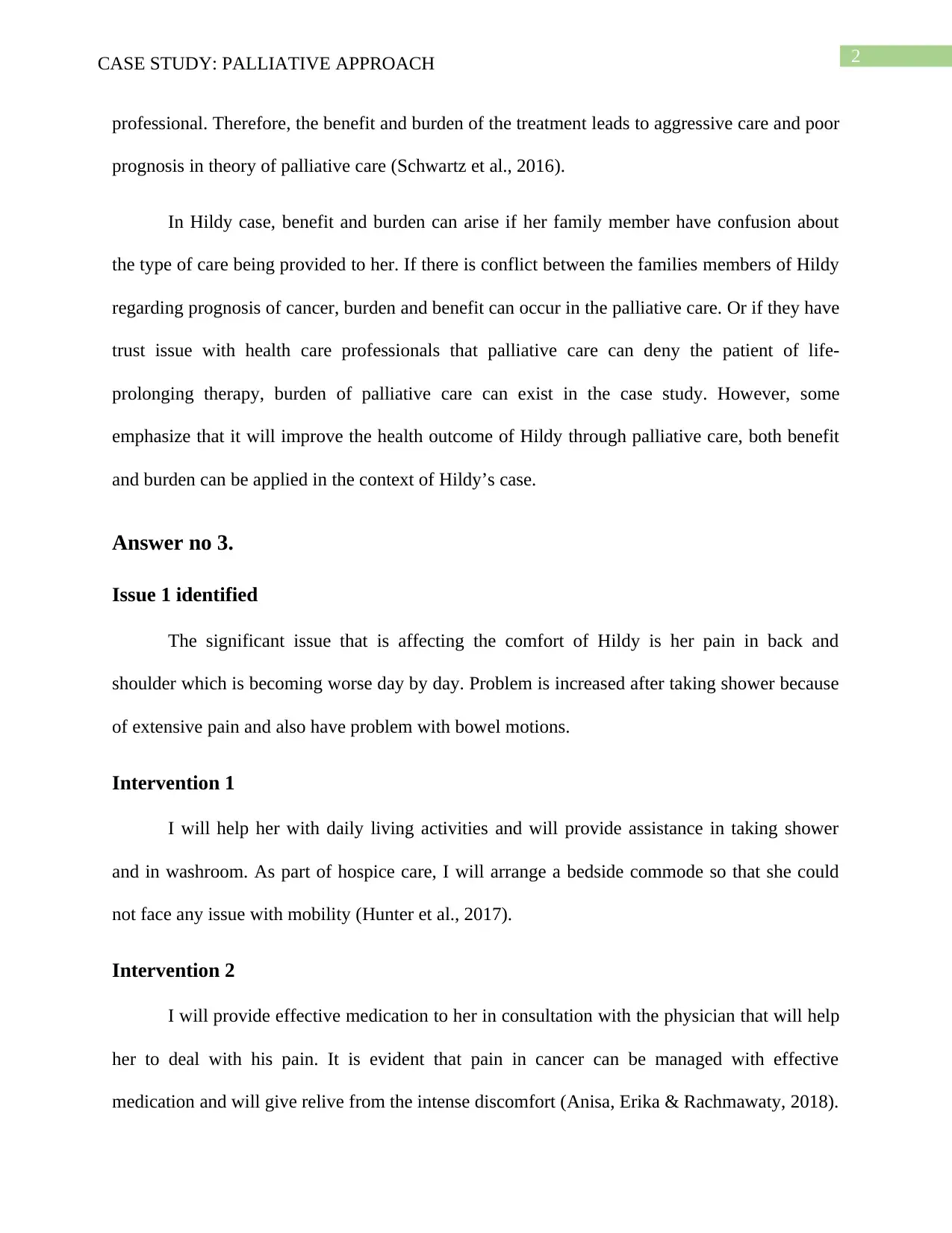
2CASE STUDY: PALLIATIVE APPROACH
professional. Therefore, the benefit and burden of the treatment leads to aggressive care and poor
prognosis in theory of palliative care (Schwartz et al., 2016).
In Hildy case, benefit and burden can arise if her family member have confusion about
the type of care being provided to her. If there is conflict between the families members of Hildy
regarding prognosis of cancer, burden and benefit can occur in the palliative care. Or if they have
trust issue with health care professionals that palliative care can deny the patient of life-
prolonging therapy, burden of palliative care can exist in the case study. However, some
emphasize that it will improve the health outcome of Hildy through palliative care, both benefit
and burden can be applied in the context of Hildy’s case.
Answer no 3.
Issue 1 identified
The significant issue that is affecting the comfort of Hildy is her pain in back and
shoulder which is becoming worse day by day. Problem is increased after taking shower because
of extensive pain and also have problem with bowel motions.
Intervention 1
I will help her with daily living activities and will provide assistance in taking shower
and in washroom. As part of hospice care, I will arrange a bedside commode so that she could
not face any issue with mobility (Hunter et al., 2017).
Intervention 2
I will provide effective medication to her in consultation with the physician that will help
her to deal with his pain. It is evident that pain in cancer can be managed with effective
medication and will give relive from the intense discomfort (Anisa, Erika & Rachmawaty, 2018).
professional. Therefore, the benefit and burden of the treatment leads to aggressive care and poor
prognosis in theory of palliative care (Schwartz et al., 2016).
In Hildy case, benefit and burden can arise if her family member have confusion about
the type of care being provided to her. If there is conflict between the families members of Hildy
regarding prognosis of cancer, burden and benefit can occur in the palliative care. Or if they have
trust issue with health care professionals that palliative care can deny the patient of life-
prolonging therapy, burden of palliative care can exist in the case study. However, some
emphasize that it will improve the health outcome of Hildy through palliative care, both benefit
and burden can be applied in the context of Hildy’s case.
Answer no 3.
Issue 1 identified
The significant issue that is affecting the comfort of Hildy is her pain in back and
shoulder which is becoming worse day by day. Problem is increased after taking shower because
of extensive pain and also have problem with bowel motions.
Intervention 1
I will help her with daily living activities and will provide assistance in taking shower
and in washroom. As part of hospice care, I will arrange a bedside commode so that she could
not face any issue with mobility (Hunter et al., 2017).
Intervention 2
I will provide effective medication to her in consultation with the physician that will help
her to deal with his pain. It is evident that pain in cancer can be managed with effective
medication and will give relive from the intense discomfort (Anisa, Erika & Rachmawaty, 2018).
⊘ This is a preview!⊘
Do you want full access?
Subscribe today to unlock all pages.

Trusted by 1+ million students worldwide
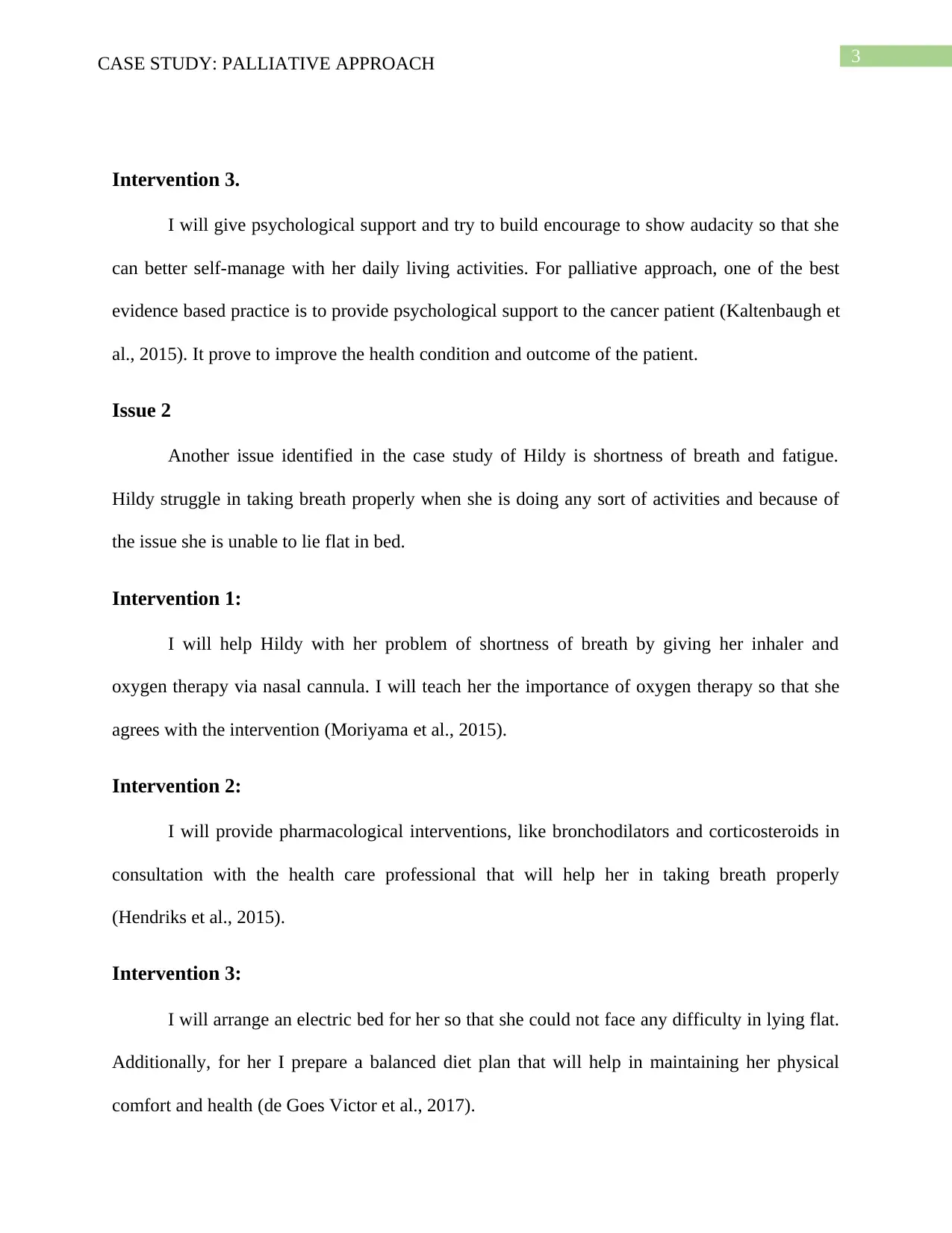
3CASE STUDY: PALLIATIVE APPROACH
Intervention 3.
I will give psychological support and try to build encourage to show audacity so that she
can better self-manage with her daily living activities. For palliative approach, one of the best
evidence based practice is to provide psychological support to the cancer patient (Kaltenbaugh et
al., 2015). It prove to improve the health condition and outcome of the patient.
Issue 2
Another issue identified in the case study of Hildy is shortness of breath and fatigue.
Hildy struggle in taking breath properly when she is doing any sort of activities and because of
the issue she is unable to lie flat in bed.
Intervention 1:
I will help Hildy with her problem of shortness of breath by giving her inhaler and
oxygen therapy via nasal cannula. I will teach her the importance of oxygen therapy so that she
agrees with the intervention (Moriyama et al., 2015).
Intervention 2:
I will provide pharmacological interventions, like bronchodilators and corticosteroids in
consultation with the health care professional that will help her in taking breath properly
(Hendriks et al., 2015).
Intervention 3:
I will arrange an electric bed for her so that she could not face any difficulty in lying flat.
Additionally, for her I prepare a balanced diet plan that will help in maintaining her physical
comfort and health (de Goes Victor et al., 2017).
Intervention 3.
I will give psychological support and try to build encourage to show audacity so that she
can better self-manage with her daily living activities. For palliative approach, one of the best
evidence based practice is to provide psychological support to the cancer patient (Kaltenbaugh et
al., 2015). It prove to improve the health condition and outcome of the patient.
Issue 2
Another issue identified in the case study of Hildy is shortness of breath and fatigue.
Hildy struggle in taking breath properly when she is doing any sort of activities and because of
the issue she is unable to lie flat in bed.
Intervention 1:
I will help Hildy with her problem of shortness of breath by giving her inhaler and
oxygen therapy via nasal cannula. I will teach her the importance of oxygen therapy so that she
agrees with the intervention (Moriyama et al., 2015).
Intervention 2:
I will provide pharmacological interventions, like bronchodilators and corticosteroids in
consultation with the health care professional that will help her in taking breath properly
(Hendriks et al., 2015).
Intervention 3:
I will arrange an electric bed for her so that she could not face any difficulty in lying flat.
Additionally, for her I prepare a balanced diet plan that will help in maintaining her physical
comfort and health (de Goes Victor et al., 2017).
Paraphrase This Document
Need a fresh take? Get an instant paraphrase of this document with our AI Paraphraser
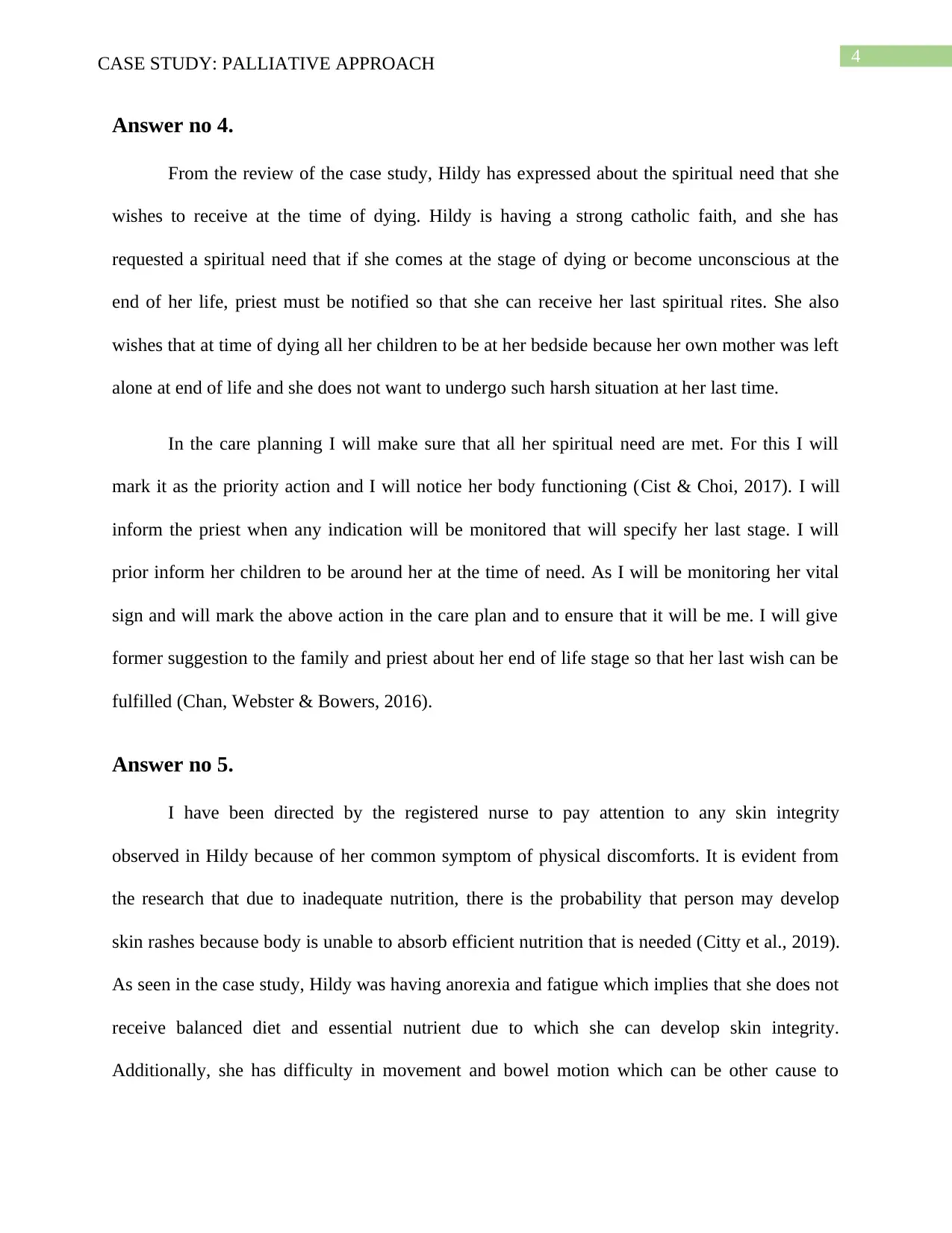
4CASE STUDY: PALLIATIVE APPROACH
Answer no 4.
From the review of the case study, Hildy has expressed about the spiritual need that she
wishes to receive at the time of dying. Hildy is having a strong catholic faith, and she has
requested a spiritual need that if she comes at the stage of dying or become unconscious at the
end of her life, priest must be notified so that she can receive her last spiritual rites. She also
wishes that at time of dying all her children to be at her bedside because her own mother was left
alone at end of life and she does not want to undergo such harsh situation at her last time.
In the care planning I will make sure that all her spiritual need are met. For this I will
mark it as the priority action and I will notice her body functioning (Cist & Choi, 2017). I will
inform the priest when any indication will be monitored that will specify her last stage. I will
prior inform her children to be around her at the time of need. As I will be monitoring her vital
sign and will mark the above action in the care plan and to ensure that it will be me. I will give
former suggestion to the family and priest about her end of life stage so that her last wish can be
fulfilled (Chan, Webster & Bowers, 2016).
Answer no 5.
I have been directed by the registered nurse to pay attention to any skin integrity
observed in Hildy because of her common symptom of physical discomforts. It is evident from
the research that due to inadequate nutrition, there is the probability that person may develop
skin rashes because body is unable to absorb efficient nutrition that is needed (Citty et al., 2019).
As seen in the case study, Hildy was having anorexia and fatigue which implies that she does not
receive balanced diet and essential nutrient due to which she can develop skin integrity.
Additionally, she has difficulty in movement and bowel motion which can be other cause to
Answer no 4.
From the review of the case study, Hildy has expressed about the spiritual need that she
wishes to receive at the time of dying. Hildy is having a strong catholic faith, and she has
requested a spiritual need that if she comes at the stage of dying or become unconscious at the
end of her life, priest must be notified so that she can receive her last spiritual rites. She also
wishes that at time of dying all her children to be at her bedside because her own mother was left
alone at end of life and she does not want to undergo such harsh situation at her last time.
In the care planning I will make sure that all her spiritual need are met. For this I will
mark it as the priority action and I will notice her body functioning (Cist & Choi, 2017). I will
inform the priest when any indication will be monitored that will specify her last stage. I will
prior inform her children to be around her at the time of need. As I will be monitoring her vital
sign and will mark the above action in the care plan and to ensure that it will be me. I will give
former suggestion to the family and priest about her end of life stage so that her last wish can be
fulfilled (Chan, Webster & Bowers, 2016).
Answer no 5.
I have been directed by the registered nurse to pay attention to any skin integrity
observed in Hildy because of her common symptom of physical discomforts. It is evident from
the research that due to inadequate nutrition, there is the probability that person may develop
skin rashes because body is unable to absorb efficient nutrition that is needed (Citty et al., 2019).
As seen in the case study, Hildy was having anorexia and fatigue which implies that she does not
receive balanced diet and essential nutrient due to which she can develop skin integrity.
Additionally, she has difficulty in movement and bowel motion which can be other cause to
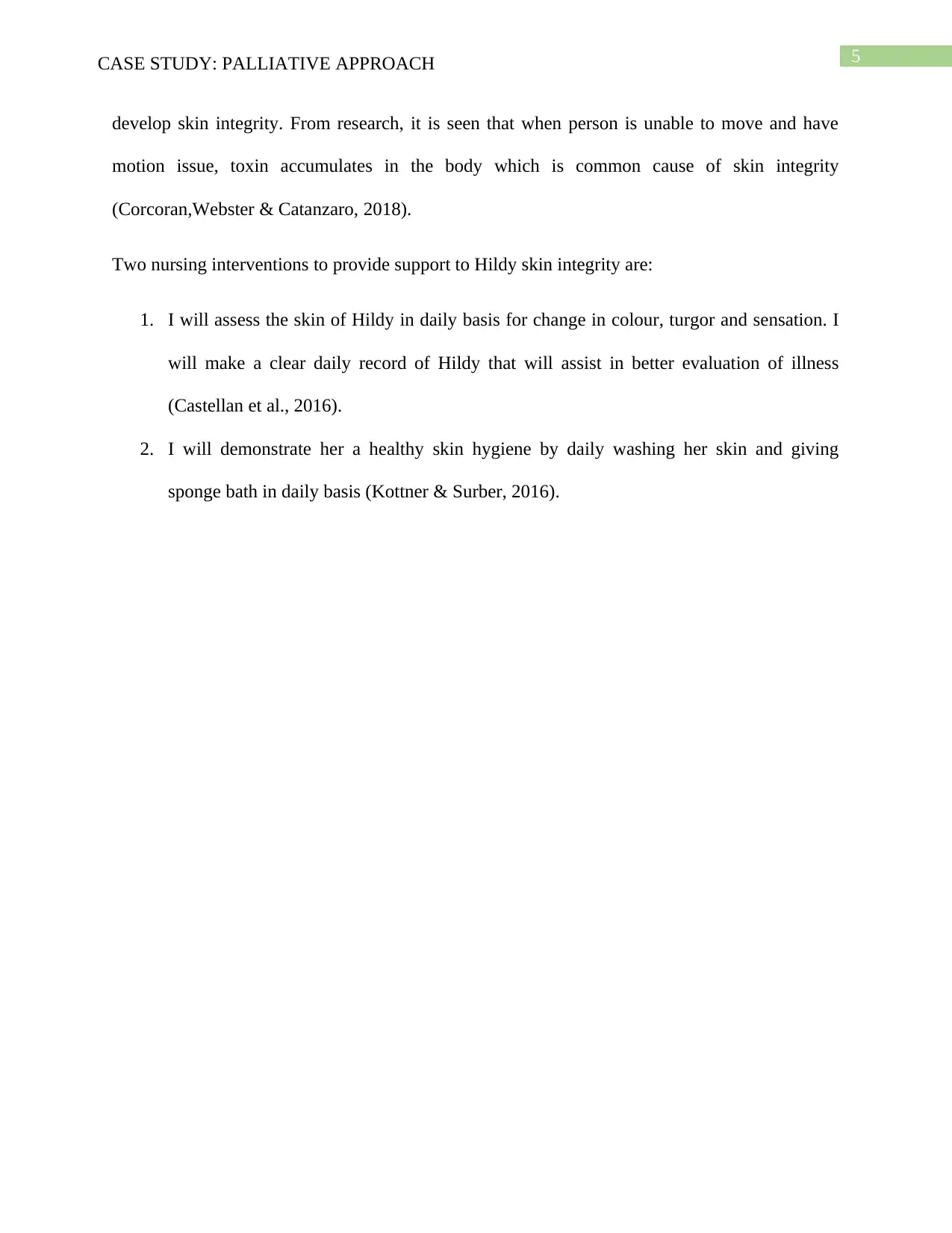
5CASE STUDY: PALLIATIVE APPROACH
develop skin integrity. From research, it is seen that when person is unable to move and have
motion issue, toxin accumulates in the body which is common cause of skin integrity
(Corcoran,Webster & Catanzaro, 2018).
Two nursing interventions to provide support to Hildy skin integrity are:
1. I will assess the skin of Hildy in daily basis for change in colour, turgor and sensation. I
will make a clear daily record of Hildy that will assist in better evaluation of illness
(Castellan et al., 2016).
2. I will demonstrate her a healthy skin hygiene by daily washing her skin and giving
sponge bath in daily basis (Kottner & Surber, 2016).
develop skin integrity. From research, it is seen that when person is unable to move and have
motion issue, toxin accumulates in the body which is common cause of skin integrity
(Corcoran,Webster & Catanzaro, 2018).
Two nursing interventions to provide support to Hildy skin integrity are:
1. I will assess the skin of Hildy in daily basis for change in colour, turgor and sensation. I
will make a clear daily record of Hildy that will assist in better evaluation of illness
(Castellan et al., 2016).
2. I will demonstrate her a healthy skin hygiene by daily washing her skin and giving
sponge bath in daily basis (Kottner & Surber, 2016).
⊘ This is a preview!⊘
Do you want full access?
Subscribe today to unlock all pages.

Trusted by 1+ million students worldwide
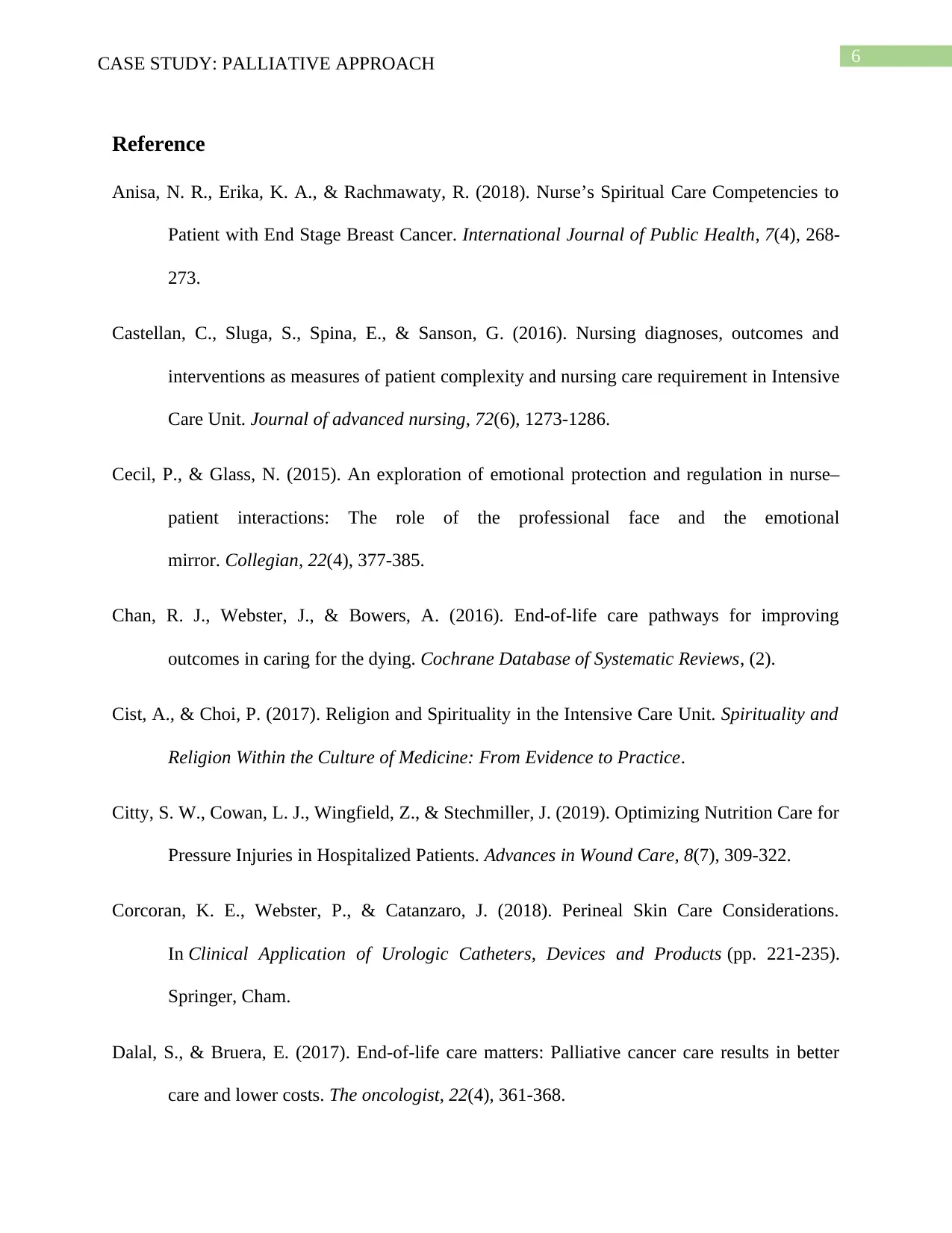
6CASE STUDY: PALLIATIVE APPROACH
Reference
Anisa, N. R., Erika, K. A., & Rachmawaty, R. (2018). Nurse’s Spiritual Care Competencies to
Patient with End Stage Breast Cancer. International Journal of Public Health, 7(4), 268-
273.
Castellan, C., Sluga, S., Spina, E., & Sanson, G. (2016). Nursing diagnoses, outcomes and
interventions as measures of patient complexity and nursing care requirement in Intensive
Care Unit. Journal of advanced nursing, 72(6), 1273-1286.
Cecil, P., & Glass, N. (2015). An exploration of emotional protection and regulation in nurse–
patient interactions: The role of the professional face and the emotional
mirror. Collegian, 22(4), 377-385.
Chan, R. J., Webster, J., & Bowers, A. (2016). End‐of‐life care pathways for improving
outcomes in caring for the dying. Cochrane Database of Systematic Reviews, (2).
Cist, A., & Choi, P. (2017). Religion and Spirituality in the Intensive Care Unit. Spirituality and
Religion Within the Culture of Medicine: From Evidence to Practice.
Citty, S. W., Cowan, L. J., Wingfield, Z., & Stechmiller, J. (2019). Optimizing Nutrition Care for
Pressure Injuries in Hospitalized Patients. Advances in Wound Care, 8(7), 309-322.
Corcoran, K. E., Webster, P., & Catanzaro, J. (2018). Perineal Skin Care Considerations.
In Clinical Application of Urologic Catheters, Devices and Products (pp. 221-235).
Springer, Cham.
Dalal, S., & Bruera, E. (2017). End‐of‐life care matters: Palliative cancer care results in better
care and lower costs. The oncologist, 22(4), 361-368.
Reference
Anisa, N. R., Erika, K. A., & Rachmawaty, R. (2018). Nurse’s Spiritual Care Competencies to
Patient with End Stage Breast Cancer. International Journal of Public Health, 7(4), 268-
273.
Castellan, C., Sluga, S., Spina, E., & Sanson, G. (2016). Nursing diagnoses, outcomes and
interventions as measures of patient complexity and nursing care requirement in Intensive
Care Unit. Journal of advanced nursing, 72(6), 1273-1286.
Cecil, P., & Glass, N. (2015). An exploration of emotional protection and regulation in nurse–
patient interactions: The role of the professional face and the emotional
mirror. Collegian, 22(4), 377-385.
Chan, R. J., Webster, J., & Bowers, A. (2016). End‐of‐life care pathways for improving
outcomes in caring for the dying. Cochrane Database of Systematic Reviews, (2).
Cist, A., & Choi, P. (2017). Religion and Spirituality in the Intensive Care Unit. Spirituality and
Religion Within the Culture of Medicine: From Evidence to Practice.
Citty, S. W., Cowan, L. J., Wingfield, Z., & Stechmiller, J. (2019). Optimizing Nutrition Care for
Pressure Injuries in Hospitalized Patients. Advances in Wound Care, 8(7), 309-322.
Corcoran, K. E., Webster, P., & Catanzaro, J. (2018). Perineal Skin Care Considerations.
In Clinical Application of Urologic Catheters, Devices and Products (pp. 221-235).
Springer, Cham.
Dalal, S., & Bruera, E. (2017). End‐of‐life care matters: Palliative cancer care results in better
care and lower costs. The oncologist, 22(4), 361-368.
Paraphrase This Document
Need a fresh take? Get an instant paraphrase of this document with our AI Paraphraser
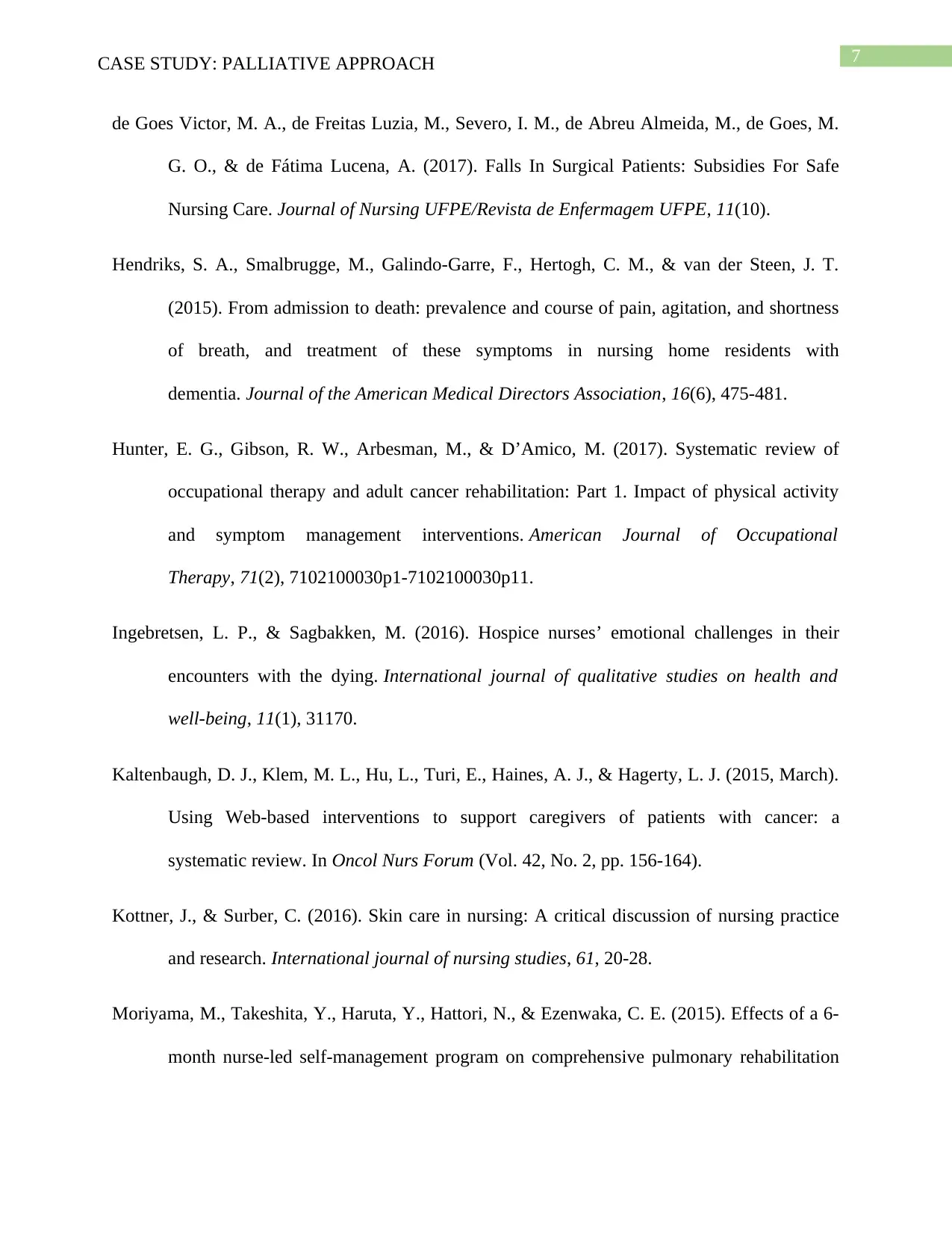
7CASE STUDY: PALLIATIVE APPROACH
de Goes Victor, M. A., de Freitas Luzia, M., Severo, I. M., de Abreu Almeida, M., de Goes, M.
G. O., & de Fátima Lucena, A. (2017). Falls In Surgical Patients: Subsidies For Safe
Nursing Care. Journal of Nursing UFPE/Revista de Enfermagem UFPE, 11(10).
Hendriks, S. A., Smalbrugge, M., Galindo-Garre, F., Hertogh, C. M., & van der Steen, J. T.
(2015). From admission to death: prevalence and course of pain, agitation, and shortness
of breath, and treatment of these symptoms in nursing home residents with
dementia. Journal of the American Medical Directors Association, 16(6), 475-481.
Hunter, E. G., Gibson, R. W., Arbesman, M., & D’Amico, M. (2017). Systematic review of
occupational therapy and adult cancer rehabilitation: Part 1. Impact of physical activity
and symptom management interventions. American Journal of Occupational
Therapy, 71(2), 7102100030p1-7102100030p11.
Ingebretsen, L. P., & Sagbakken, M. (2016). Hospice nurses’ emotional challenges in their
encounters with the dying. International journal of qualitative studies on health and
well-being, 11(1), 31170.
Kaltenbaugh, D. J., Klem, M. L., Hu, L., Turi, E., Haines, A. J., & Hagerty, L. J. (2015, March).
Using Web-based interventions to support caregivers of patients with cancer: a
systematic review. In Oncol Nurs Forum (Vol. 42, No. 2, pp. 156-164).
Kottner, J., & Surber, C. (2016). Skin care in nursing: A critical discussion of nursing practice
and research. International journal of nursing studies, 61, 20-28.
Moriyama, M., Takeshita, Y., Haruta, Y., Hattori, N., & Ezenwaka, C. E. (2015). Effects of a 6‐
month nurse‐led self‐management program on comprehensive pulmonary rehabilitation
de Goes Victor, M. A., de Freitas Luzia, M., Severo, I. M., de Abreu Almeida, M., de Goes, M.
G. O., & de Fátima Lucena, A. (2017). Falls In Surgical Patients: Subsidies For Safe
Nursing Care. Journal of Nursing UFPE/Revista de Enfermagem UFPE, 11(10).
Hendriks, S. A., Smalbrugge, M., Galindo-Garre, F., Hertogh, C. M., & van der Steen, J. T.
(2015). From admission to death: prevalence and course of pain, agitation, and shortness
of breath, and treatment of these symptoms in nursing home residents with
dementia. Journal of the American Medical Directors Association, 16(6), 475-481.
Hunter, E. G., Gibson, R. W., Arbesman, M., & D’Amico, M. (2017). Systematic review of
occupational therapy and adult cancer rehabilitation: Part 1. Impact of physical activity
and symptom management interventions. American Journal of Occupational
Therapy, 71(2), 7102100030p1-7102100030p11.
Ingebretsen, L. P., & Sagbakken, M. (2016). Hospice nurses’ emotional challenges in their
encounters with the dying. International journal of qualitative studies on health and
well-being, 11(1), 31170.
Kaltenbaugh, D. J., Klem, M. L., Hu, L., Turi, E., Haines, A. J., & Hagerty, L. J. (2015, March).
Using Web-based interventions to support caregivers of patients with cancer: a
systematic review. In Oncol Nurs Forum (Vol. 42, No. 2, pp. 156-164).
Kottner, J., & Surber, C. (2016). Skin care in nursing: A critical discussion of nursing practice
and research. International journal of nursing studies, 61, 20-28.
Moriyama, M., Takeshita, Y., Haruta, Y., Hattori, N., & Ezenwaka, C. E. (2015). Effects of a 6‐
month nurse‐led self‐management program on comprehensive pulmonary rehabilitation
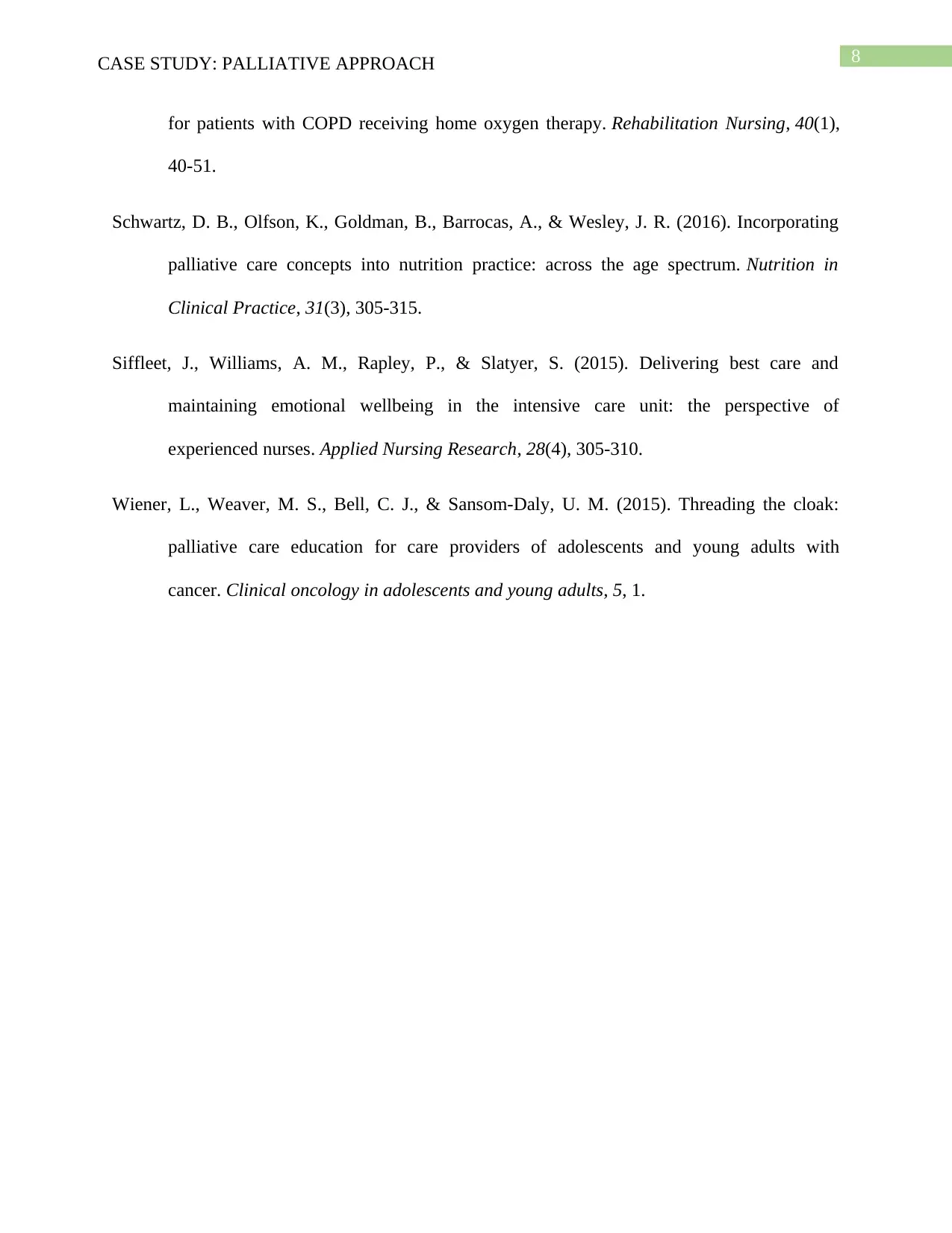
8CASE STUDY: PALLIATIVE APPROACH
for patients with COPD receiving home oxygen therapy. Rehabilitation Nursing, 40(1),
40-51.
Schwartz, D. B., Olfson, K., Goldman, B., Barrocas, A., & Wesley, J. R. (2016). Incorporating
palliative care concepts into nutrition practice: across the age spectrum. Nutrition in
Clinical Practice, 31(3), 305-315.
Siffleet, J., Williams, A. M., Rapley, P., & Slatyer, S. (2015). Delivering best care and
maintaining emotional wellbeing in the intensive care unit: the perspective of
experienced nurses. Applied Nursing Research, 28(4), 305-310.
Wiener, L., Weaver, M. S., Bell, C. J., & Sansom-Daly, U. M. (2015). Threading the cloak:
palliative care education for care providers of adolescents and young adults with
cancer. Clinical oncology in adolescents and young adults, 5, 1.
for patients with COPD receiving home oxygen therapy. Rehabilitation Nursing, 40(1),
40-51.
Schwartz, D. B., Olfson, K., Goldman, B., Barrocas, A., & Wesley, J. R. (2016). Incorporating
palliative care concepts into nutrition practice: across the age spectrum. Nutrition in
Clinical Practice, 31(3), 305-315.
Siffleet, J., Williams, A. M., Rapley, P., & Slatyer, S. (2015). Delivering best care and
maintaining emotional wellbeing in the intensive care unit: the perspective of
experienced nurses. Applied Nursing Research, 28(4), 305-310.
Wiener, L., Weaver, M. S., Bell, C. J., & Sansom-Daly, U. M. (2015). Threading the cloak:
palliative care education for care providers of adolescents and young adults with
cancer. Clinical oncology in adolescents and young adults, 5, 1.
⊘ This is a preview!⊘
Do you want full access?
Subscribe today to unlock all pages.

Trusted by 1+ million students worldwide
1 out of 9
Related Documents
Your All-in-One AI-Powered Toolkit for Academic Success.
+13062052269
info@desklib.com
Available 24*7 on WhatsApp / Email
![[object Object]](/_next/static/media/star-bottom.7253800d.svg)
Unlock your academic potential
Copyright © 2020–2025 A2Z Services. All Rights Reserved. Developed and managed by ZUCOL.





